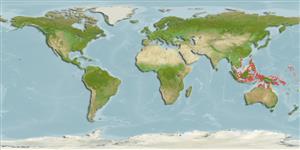>
Ovalentaria/misc (Various families in series Ovalentaria) >
Pomacentridae (Damselfishes) > Pomacentrinae
Etymology: Dischistodus: Greek, di = two + Greek, schistos = fissile stone, Plinius + Greek, odous = teeth (Ref. 45335).
More on author: Cuvier.
Environment: milieu / Klimaatzone / Diepte / distribution range
Ecologie
marien rifbewoner; standvastig; diepte 1 - 8 m (Ref. 7247). Tropical; 21°N - 20°S
Western Pacific: Indonesia, Philippines and northern Australia.
Grootte / Gewicht / Leeftijd
Maturiteit: Lm ? range ? - ? cm
Max length : 11.5 cm SL mannelijk / geslacht onbekend; (Ref. 7247)
Korte beschrijving
Determinatiesleutels | Morfologie | Morfometrie
Dorsale stekels (totaal) : 13; Dorsale zachte stralen (totaal) : 13 - 14; Anale stekels: 2; Anale zachte stralen: 13 - 14.
Body shape (shape guide): fusiform / normal; Cross section: compressed.
Adults inhabit silty lagoon and coastal reefs around coral outcrops and seagrass beds (Ref. 9710). Often adjacent to clear mangrove coasts among rubble and Sargassum algae, to a few meters depth (Ref. 48636). Oviparous, distinct pairing during breeding (Ref. 205). Eggs are demersal and adhere to the substrate (Ref. 205). Males guard and aerate the eggs (Ref. 205). Diurnal species (Ref. 52881).
Levenscyclus en paargedrag
Maturiteit | Voortplanting | Paaien | Eieren | Fecunditeit | Larven
Oviparous, distinct pairing during breeding (Ref. 205). Eggs are demersal and adhere to the substrate (Ref. 205). Males guard and aerate the eggs (Ref. 205).
Allen, G.R., 1991. Damselfishes of the world. Mergus Publishers, Melle, Germany. 271 p. (Ref. 7247)
Status op de Rode Lijst van het IUCN (Ref. 130435: Version 2025-1)
Gevaar voor de mens
Harmless
Gebruik door de mens
Tools
Speciale rapporten
Download XML
Internetbronnen
Estimates based on models
Preferred temperature (Ref.
123201): 27.6 - 29.3, mean 28.8 °C (based on 1291 cells).
Fylogenetische diversiteitsindex (Ref.
82804): PD
50 = 0.5078 [Uniqueness, from 0.5 = low to 2.0 = high].
Bayesian length-weight: a=0.01479 (0.00651 - 0.03363), b=3.00 (2.81 - 3.19), in cm total length, based on LWR estimates for this (Sub)family-body shape (Ref.
93245).
Trofisch niveau (Ref.
69278): 2.0 ±0.00 se; based on food items.
Weerstandsvermogen (Ref.
120179): Hoog, minimale populatieverdubbelingstijd minder dan 15 maanden (Preliminary K or Fecundity.).
Fishing Vulnerability (Ref.
59153): Low vulnerability (10 of 100).
🛈
Nutrients (Ref.
124155): Calcium = 123 [64, 213] mg/100g; Iron = 0.836 [0.478, 1.391] mg/100g; Protein = 18.4 [17.2, 19.5] %; Omega3 = 0.118 [0.069, 0.200] g/100g; Selenium = 18.1 [9.9, 36.2] μg/100g; VitaminA = 129 [35, 457] μg/100g; Zinc = 2.48 [1.66, 3.57] mg/100g (wet weight);
